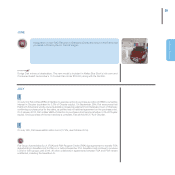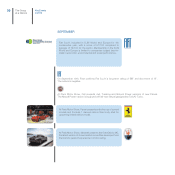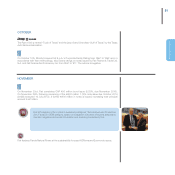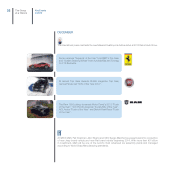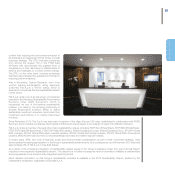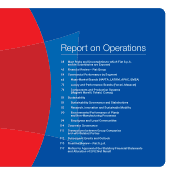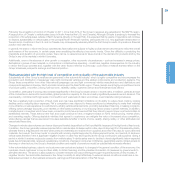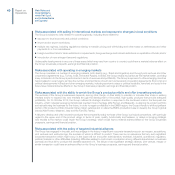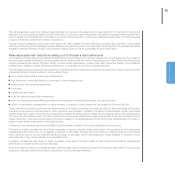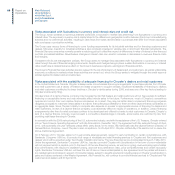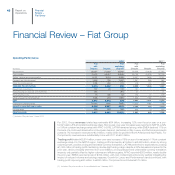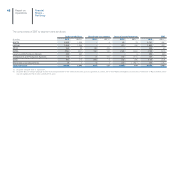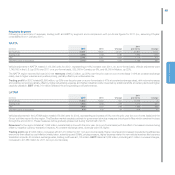Chrysler 2012 Annual Report Download - page 40
Download and view the complete annual report
Please find page 40 of the 2012 Chrysler annual report below. You can navigate through the pages in the report by either clicking on the pages listed below, or by using the keyword search tool below to find specific information within the annual report.
39
Report on Operations
Following the acquisition of control of Chrysler in 2011, more than 50% of the Group’s revenues are generated in the NAFTA region.
A large portion of Chrysler’s vehicle sales occur in North America (the U.S. and Canada). Although Chrysler is seeking to increase the
proportion of its vehicle sales outside of North America (directly or through Fiat), it is expected that its results of operations will continue
to depend substantially on vehicle sales in the principal North American markets, particularly the U.S. Any significant deterioration in
the economic conditions in the U.S. and/or Canada may consequently adversely affect the Fiat Group’s results of operations, financial
position and cash flows.
In general, the sector in which the Group operates has historically been subject to highly cyclical demand and tends to reflect the overall
performance of the economy, in certain cases even amplifying the effects of economic trends. Given the difficulty in predicting the
magnitude and duration of economic cycles, there can be no assurances as to future trends in the demand for products sold by the
Group in any of the markets in which it operates.
Additionally, even in the absence of slow growth or recession, other economic circumstances – such as increases in energy prices,
fluctuations in prices of raw materials or contractions in infrastructure spending – could have negative consequences for the industry
in which the Group operates and, together with the other factors referred to previously, could have a material adverse effect on the
Group’s business prospects, earnings and financial position.
Risks associated with the high level of competition and cyclicality of the automobile industry
Substantially all of the Group’s revenues are generated in the automobile industry, which is highly competitive and encompasses the
production and distribution of passenger cars, light commercial vehicles and the related components and production systems. The
Group faces competition from other international passenger car and light commercial vehicle manufacturers and distributors and
components suppliers in Europe, North and Latin America and the Asia Pacific region. These markets are all highly competitive in terms
of product quality, innovation, pricing, fuel economy, reliability, safety, customer service and financial services offered.
Competition, particularly in pricing, has increased significantly in the Group’s industry sector in recent years. In addition, partly as a result
of the contraction in demand for automobiles, global production capacity for the car industry significantly exceeds current demand. This
overcapacity, combined with high levels of competition and weakness of major economies, could intensify pricing pressures.
Fiat has a relatively high proportion of fixed costs and may have significant limitations on its ability to reduce fixed costs by closing
facilities and/or reducing labor expenses. Fiat’s competitors may respond to these conditions by attempting to make their vehicles
more attractive or less expensive to customers by adding vehicle enhancements, providing subsidized financing or leasing programs,
offering option package discounts, price rebates or other sales incentives, or by reducing vehicle prices in certain markets. In addition,
manufacturers in countries which have lower production costs have announced that they intend to export lower-cost automobiles to
established markets. These actions have had, and could continue to have, a negative impact on Fiat’s vehicle pricing, market share,
and operating results. Offering desirable vehicles that appeal to customers can mitigate the risks of increased price competition,
while offering vehicles that are perceived to be less desirable (whether in terms of price, quality, styling, safety, or other attributes) can
exacerbate these risks.
Changes in vehicle sales volumes can have a disproportionately large effect on Fiat’s profitability because of the high level of fixed costs.
In addition, the Group generally receives payments from vehicle sales to dealers within a few days of shipment from the assembly plants,
whereas there is a lag between the time when parts and materials are received from suppliers and when Fiat pays for such parts and
materials. As a result, the Group tends to operate with working capital supported by these payment terms, and periods of decline in
vehicle sales therefore have a significant negative impact on cash flow and liquidity as the Group continues to pay suppliers during a
period in which it receives reduced proceeds from vehicle sales. If vehicle sales were to decline to levels significantly below expected
levels due to financial crisis, renewed recessionary conditions, changes in consumer confidence, geopolitical events, limited access to
financing or other factors, the Group’s financial condition and results of operations would be substantially adversely affected.
In the automobiles business, sales to end customers are cyclical and subject to changes in the general condition of the economy, the
readiness of end customers to buy and their ability to obtain financing and the possible introduction of measures by governments to
stimulate demand. The sector is also subject to constant renewal of product offerings through frequent launches of new models. A
negative trend in the automobile business or the Group’s inability to adapt effectively to external market conditions could have a ma-
terial adverse impact on the business prospects, earnings and financial position of the Fiat Group.


